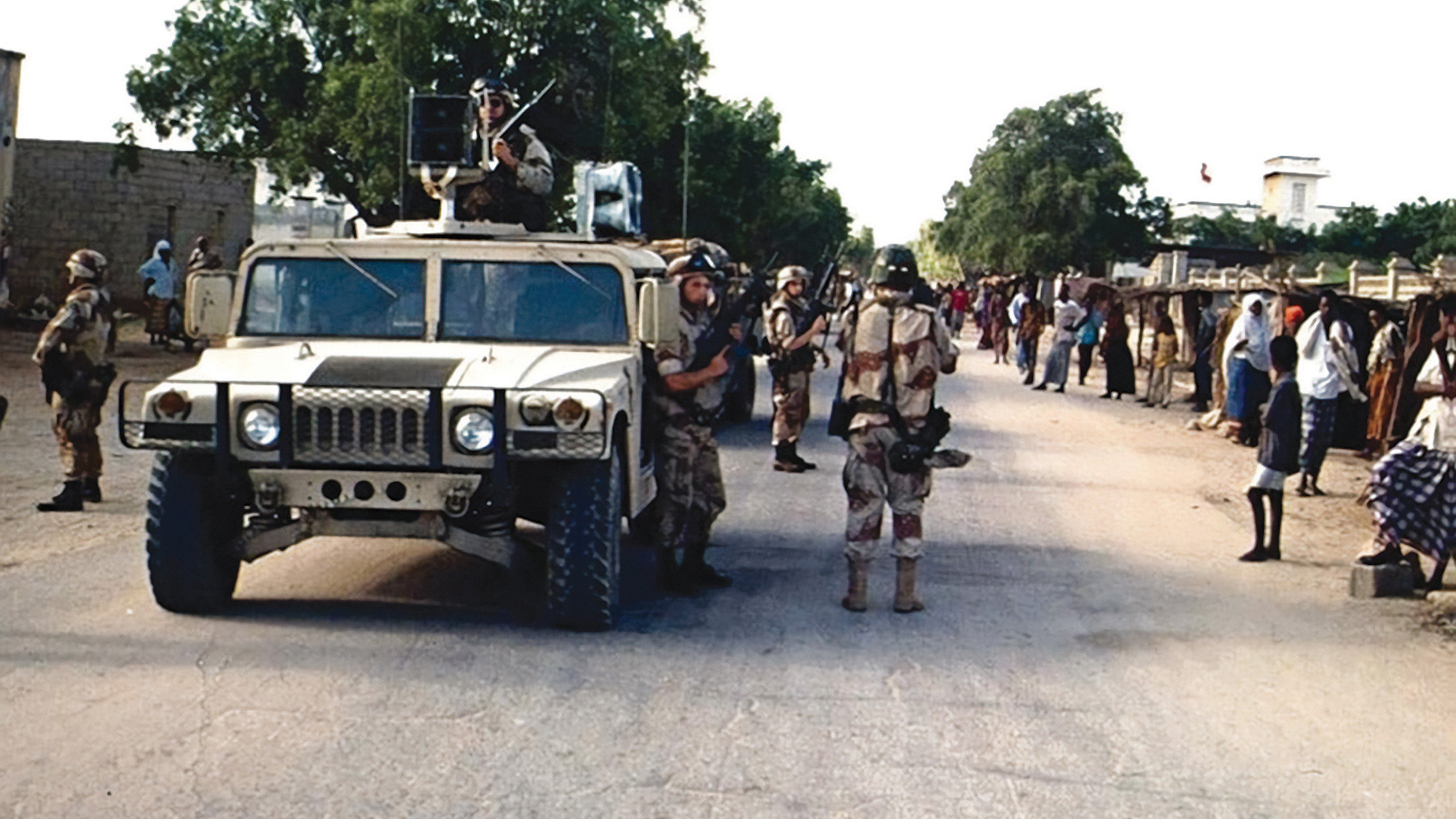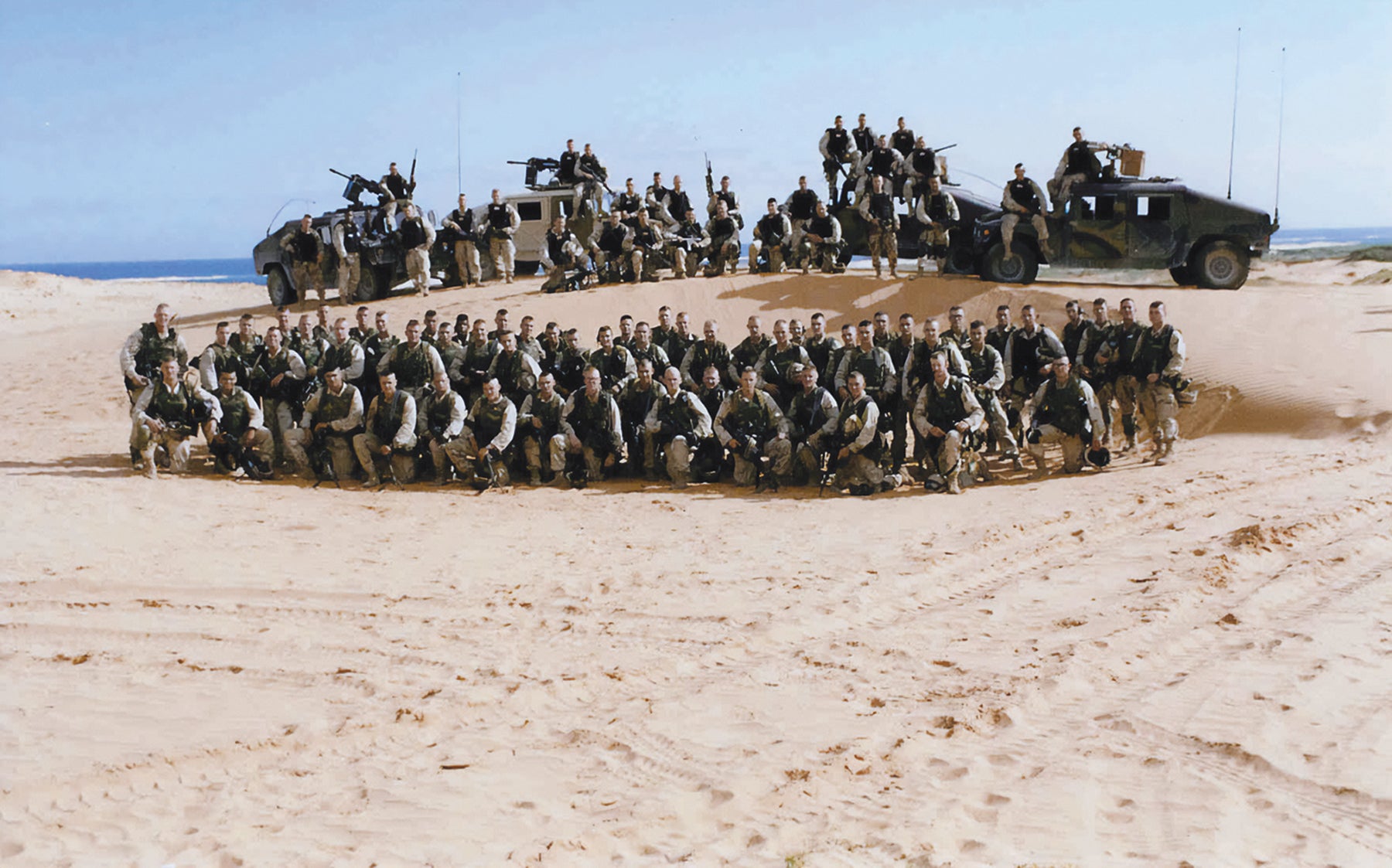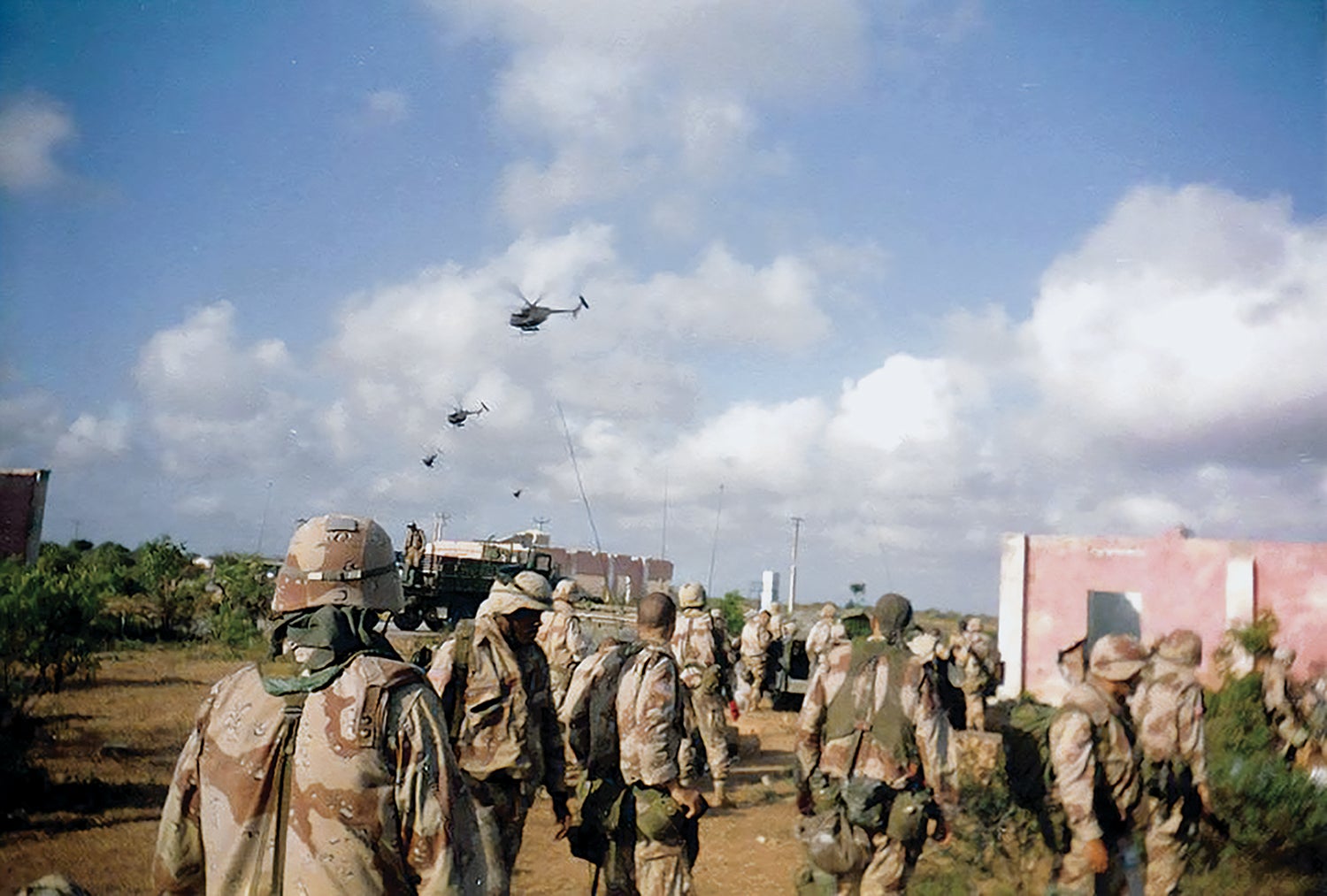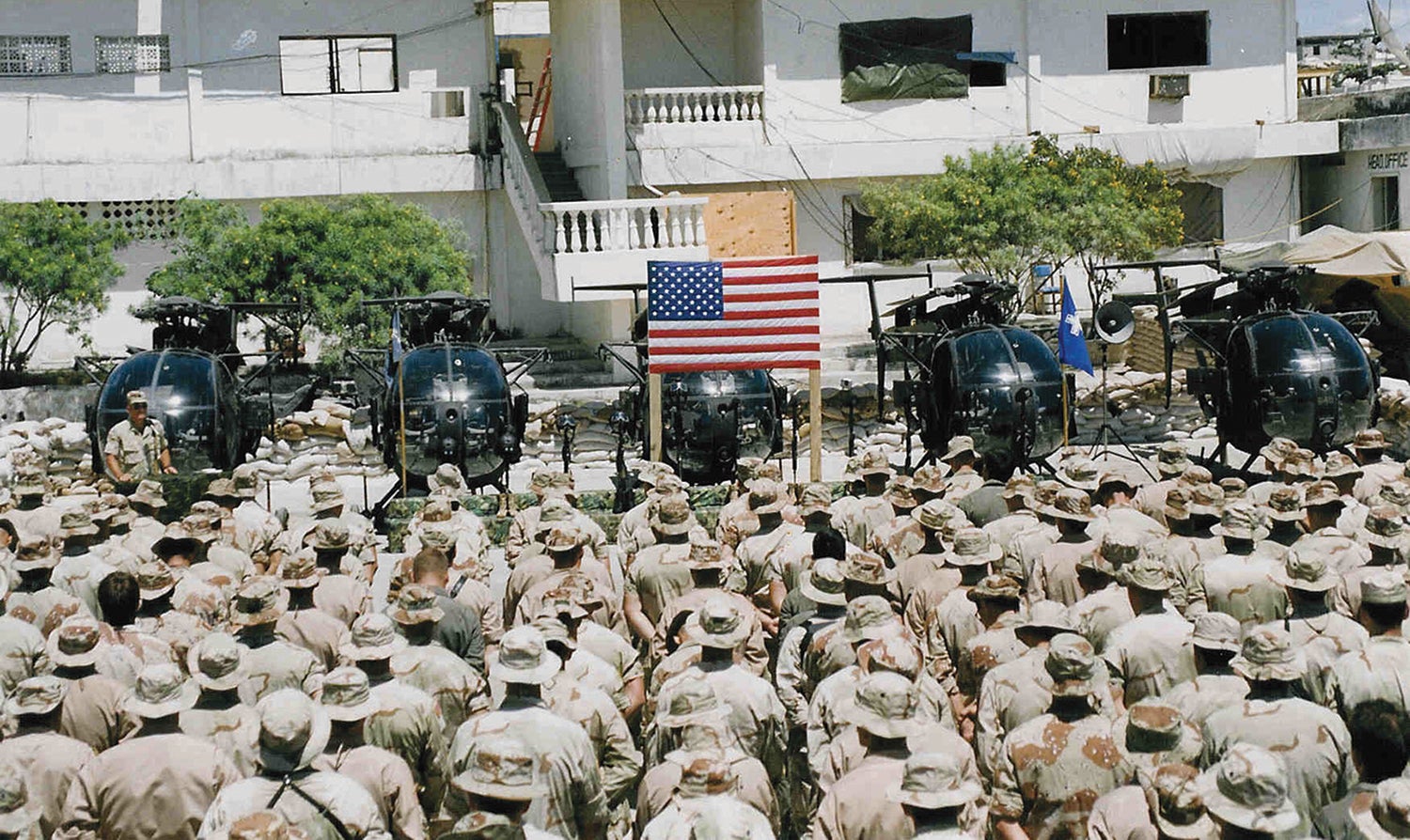Maj. Gen. David Meade had seen enough after less than 48 hours on the ground in Somalia, where he had 1,200 soldiers deployed as a quick-reaction force.
The 10th Mountain Division commander reported to his superiors: “We have a war going on in Somalia. From a tactical and maybe operational perspective it is not going well.” In the secret Sept. 15, 1993, memo that has since been declassified, Meade said the security situation was trending in the wrong direction, and Mogadishu “is not under our control. Somalia is full of danger.”
In his memo, declassified in 1994, Meade wrote that he wasn’t a Somalia expert, but he believed that getting out of the country was the best of three bad choices.
Continuing the war against Somali warlord Mohamed Farah Aidid “flirts with disaster of considerable proportion … unless the enemy cooperates—and there’s no indication he will,” wrote Meade, who retired from the Army in 1995 and died in October 2019.
“I’m sorry that this is not an upbeat picture. Your soldiers are great. The war is a mess and headed in the wrong direction,” he wrote.
Less than three weeks later, on Oct. 3 and 4, Meade’s warnings turned into a deadly reality when a daytime mission to capture two of Aidid’s top lieutenants went awry. Two MH-60 Black Hawk helicopters were shot down by rocket-propelled grenades, and Somali fighters swarmed the streets.

A full-scale battle raged for more than 15 hours. Eighteen U.S. troops were killed and many more wounded, according to DoD.
This October marks the 30th anniversary of the Battle of Mogadishu, made famous by the book and subsequent movie, Black Hawk Down. Although tactically successful, the battle, fought as part of Operation Gothic Serpent, was the bloodiest combat the U.S. military had experienced since the Vietnam War.
The battle also revealed shortfalls in U.S. assumptions on the use of military force in the post-Cold War era, transformed the strategic landscape and reverberated globally in ways still felt today.
Three decades later, it is still appropriate to ask questions about the legacy of the battle and its relevance in an era of great-power competition. It’s also worth examining whether the battle was an anomaly in the brief era of uncontested U.S. supremacy or a harbinger of what to expect.
Peace Dividend?
The first decade of the post-Cold War era saw rapid and turbulent change in the geopolitical landscape. The Warsaw Pact was disintegrating, marked by the Soviet withdrawal from Afghanistan in February 1989, the fall of the Berlin Wall in November 1989 and the dissolution of the USSR in December 1991.
With no peer adversary, the U.S. drastically downsized its military in pursuit of a peace dividend. Perhaps overconfident, the U.S. possessed unparalleled military capabilities that it demonstrated to the world in its 1991 defeat of Iraqi leader Saddam Hussein during Operation Desert Storm.
The U.N., too, was emboldened, freed from the constraints of great-power rivalry and eager to advance its humanitarian pursuits.
Long plagued by political instability, severe climate and internecine clan warfare, Somalia was going to prove a harsh testing ground for both the U.S. and the U.N. and their assumptions regarding the new world order.

Critical Need
In 1991, rival clans overthrew President Siad Barre due to his ruthless and ineffectual leadership. The resulting power vacuum led to a breakdown in government services, civil war between competing clans and famine for the Somali people. Countless Somalis left the countryside for the cities in search of food.
“Somalia is a dismal country that has walked fewer steps away from the stone age than most,” Meade wrote in his 13-page memo. “They have been fighting a venomous and deadly civil war that has killed their people in great numbers, and ruined what was previously passable about life there.”
He added, “Hardship, pain, suffering and death are a part of their daily existence. Most know nothing else and expect nothing else. They are not greatly dissuaded by threats or violence.”
Shocked by the images of millions of starving children, the international community responded with humanitarian aid and missions to Somalia: U.N. Operation in Somalia (UNOSOM) in April 1992 and UNOSOM II in March 1993.
In December 1992, President George H.W. Bush announced that the U.S. was sending forces to protect aid workers and stabilize the situation in Somalia as part of Operation Restore Hope.
These initiatives had positive results. The combined efforts of UNOSOM and Restore Hope resulted in humanitarian relief that saved hundreds of thousands of lives and helped tamp down the violence that had disrupted the delivery of aid.
However, neither initiative directly addressed the underlying causes for the pervasive instability in Somalia—nor was it their mission to do so.
Violence Prevails
In May 1993, U.S. and U.N. troop presence decreased significantly as the humanitarian crisis eased. But the troublesome militias remained—and the U.N. and the U.S. raised their ambitions, even as troop strength declined, to create the conditions for long-term stability by neutralizing the militias that were perpetuating violence.
As the summer wore on, Aidid, leader of the Somali National Alliance, launched increasingly intense attacks on remaining aid workers and peacekeepers. He felt they were encroaching on his power base, and he claimed there were unjustified attacks on Somali civilians by American troops.
In August 1993, after several attacks killed or wounded U.S. soldiers, President Bill Clinton approved Operation Gothic Serpent, deploying the 441-man Task Force Ranger to hunt down Aidid.
The Battle
On Oct. 3, Task Force Ranger received intelligence that two of Aidid’s key subordinates were going to meet at the Olympic Hotel in Mogadishu’s Bakara Market district. In a repeat of a tactical play they had run six times before, four teams of Delta Force operators on MH-6 Little Bird helicopters would insert into the center of the hotel compound, quickly clear four target buildings and capture Aidid’s men. Nearly simultaneously, Army Rangers in four MH-60 Black Hawks would fast-rope to the corners of the city block surrounding the target to provide external security. A ground convoy from the airfield would move to the target site and extricate the prisoners with the Delta operators and Rangers.

The Outcome
The Delta Force insertion went according to plan, with the assault teams quickly capturing the two Aidid deputies along with some 20 other militia members. While conducting their security force insertion, one Black Hawk struggled to stabilize as its team was fast-roping in dusty brownout conditions, and a Ranger, unable to secure the rope, fell more than 60 feet to the street and was severely injured.
Aidid’s militia, reinforced with irregular volunteers soon numbering in the thousands, swarmed the streets and shot down two Black Hawks using rocket-propelled grenades.
The ensuing battle resulted in the death of 18 U.S. soldiers and some 80 wounded from an assault force of 160. Many hundreds of Somalis were killed, if not more.
For their heroic actions—including their repeated insistence on being dropped into a hornet’s nest of militia swarming the site of one of the crashed Black Hawks, Delta Force snipers Master Sgt. Gary Gordon and Sgt. 1st Class Randy Shugart were posthumously awarded the Medal of Honor.
The mission was a tactical success—resulting in the capture of Aidid’s key leaders—yet it was a Pyrrhic victory. The corresponding strategic and information space failure was vividly displayed by the Somali National Alliance flaunting a captured U.S. pilot on television and the horrific imagery of dead U.S. soldiers being dragged through the streets.
The American public and the world took notice. On Oct. 7, Clinton announced the withdrawal of U.S. forces by March 31, 1994.
The implications were profound.
The perception of U.S. weakness and proclivity to withdraw after its first casualties emboldened al-Qaida. The terror group’s founder, Osama bin Laden, then living in Sudan, cited this battle and America’s withdrawal as an example of American weakness. Evidence suggests that this influenced al-Qaida decisions to attack the U.S. in the coming decade—the U.S. Embassy bombings in Tanzania and Kenya in August 1998, the USS Cole bombing in 2000 and the 9/11 attacks on the U.S. homeland.
American Outrage
Domestically, there was outrage at the desecration of the American soldiers and exploitation on TV of the captured pilot, Chief Warrant Officer 2 Mike Durant. Confusion regarding U.S. objectives in Somalia and why Defense Secretary Les Aspin had denied a request for armored vehicles that could have mitigated some risk caused additional turmoil. While Maj. Gen. William Garrison, Task Force Ranger commander, asserted that Aspin was not at fault, the defense secretary resigned in December 1993.
Humbled, the U.S. became less inclined to put American boots on the ground in potentially hostile environments. In 1994, the U.S. and the world chose not to get involved in Rwanda when Hutus butchered perhaps 1 million Tutsis, and delayed involvement to prevent war crimes in Bosnia in 1995 and ethnic cleansing in Kosovo in 1999.
For Somalia, its U.N. support diminished and the U.S. departed, interclan warfare returned to the fore, al-Qaida affiliate al-Shabaab metastasized, and three more decades of civil war ensued.

Risk Factors
It is useful to look at factors that influenced the tactical actions that had a disproportionate effect on the strategic outcome.
Task Force Ranger repeated similar tactics—or battle drills—for each raid. While there were good reasons for doing so, including familiarity, flexibility and speed, the risks increased each time as hostile forces learned and adapted.
Optimistic assumptions also drove up risk. With missions planned to last 30 to 60 minutes, there were limitations on the amount of ammunition, water and night-vision equipment the troops carried. While this has received some scrutiny, there was a trade-off between speed and staying power. The capacity of these critical items was limited to what a soldier could carry while fast-roping from a helicopter. Anything more would slow a mission in which speed and surprise were key.
Task Force Ranger may have underestimated its adversary’s capability. To counter the task force, the Somali National Alliance militia developed countermeasures, including lookouts, an effective signaling system that used burning tires and hasty ambushes to delay arrival of reinforcements.
In the early 19th century, war theorist Karl von Clausewitz wrote that “the first, the supreme, the most far-reaching act of judgment that the statesman and commander have to make is to establish … the kind of war on which they are embarking, neither mistaking it for, nor trying to turn it into, something that is alien to its nature.”
Important Lessons
As tall a task as this may be, leaders must continually update their assessments regarding the nature and characteristics of situational changes.
The U.S. mission in Somalia evolved from humanitarian relief to peacekeeping and, ultimately, combat over the course of a few months. Meade’s report in September 1993 described this disruptive evolution on the ground and associated risks the U.S. government had not mitigated. The steep learning curve of a new presidential administration made it even more challenging to synchronize strategic objectives, assumptions, resources and risk in the face of the evolving situation.
Arbitrary limitations on troop levels, rules of engagement and authorized weapons—in order not to escalate tensions, the U.S. did not deploy armor to Somalia—are inevitable because wars are fought for political purposes. Military leaders must articulate and mitigate increased associated risk and strive to ensure that their civilian leaders understand.
Despite altruistic motivations for providing humanitarian aid to famine-plagued populations, delivering aid is not a neutral or benign action. It can affect the power dynamics of local and regional actors, some of whom may view it as a threat to their influence or economic opportunities. Donors do not decide how recipients perceive the aid—in the case of Somalia in 1993, Aidid did.
The last, and perhaps most important, lesson is that even when there are different levels of technology available to the combatants, close and violent combat between warriors on the ground where people live remains the ultimate arbiter in war.

Messy Situations
While the Battle of Mogadishu was fought against a nonstate actor in a failed state when the U.S. was the world’s sole superpower, similar situations could arise in an era of great-power competition.
There will be contested spaces in “economy of force” locations that may require peacekeeping, peace enforcement and fighting below open conflict between major powers. It is likely the U.S. will need to get into certain messy situations or otherwise cede strategic influence to its competitors.
As the U.S. Forces, Somalia after-action review concluded, the U.S. “may not be able or desire to avoid participation in operations that attempt to prevent, contain, or resolve similar conflicts. Properly constituted, peace operations can be a useful tool to advance United States national interests and pursue our security objectives.”
While the U.S. worked to support U.N. efforts to help Somalia, collective efforts regressed from aid delivery to targeting factions that were attacking U.N. peacekeepers and aid workers.
The good intentions of the international community to alleviate the humanitarian catastrophe were laudable, yet by aiming too high without first setting the necessary conditions, there was a drift toward disaster in a classic example of mission creep.
The U.S. will encounter ambiguous conflicts during great-power competition. Military and civilian leaders must make a deliberate assessment of the nature of each situation to avoid incrementalism and mission creep. It will be imperative to keep ends, ways, means and risks in proper proportion. Otherwise, the U.S. may find itself in a similar strategic situation as it did in Somalia, in which “getting out” is the best of its bad choices.
* * *
Col. Daniel Roper, U.S. Army retired, is director of National Security Studies at the Association of the U.S. Army. A career artilleryman, he commanded at the battery, battalion and brigade levels, with his final assignment as director of the then-U.S. Army Counterinsurgency Center, Fort Leavenworth, Kansas. He deployed to Afghanistan and Iraq. He is a graduate of the U.S. Military Academy, West Point, New York. He has three master’s degrees: one in nuclear physics from the Naval Postgraduate School and two in military art and science from the School of Advanced Military Studies.

